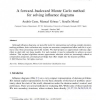10 search results - page 2 / 2 » Multi-Agent Influence Diagrams for Representing and Solving ... |
IJAR
2006
13 years 5 months ago
2006
Although influence diagrams are powerful tools for representing and solving complex decisionmaking problems, their evaluation may require an enormous computational effort and this...
UAI
2004
13 years 6 months ago
2004
Mixtures of truncated exponentials (MTE) potentials are an alternative to discretization for representing continuous chance variables in influence diagrams. Also, MTE potentials c...
FLAIRS
2001
13 years 6 months ago
2001
Thewidespreaduse of influence diagramsto represent andsolve Bayesiandecision problemsis still limited by the inflexibility andrather restrictive semanticsof influence diagrams. In...
DSRT
2003
IEEE
13 years 10 months ago
2003
IEEE
Distributed simulation enables participants situated in different geographical locations to share a common virtual world, which is called a Distributed Virtual Environment (DVE). ...
AAAI
2008
13 years 7 months ago
2008
This paper examines, by argument, the dynamics of sequences of behavioural choices made, when non-cooperative restricted-memory agents learn in partially observable stochastic gam...

